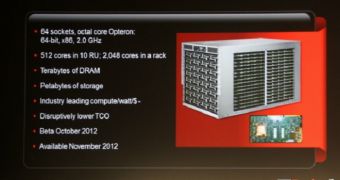We always wondered why AMD isn’t building servers of its own. If Intel is obviously paying off system builders not to offer AMD-based systems, servers or laptops, AMD should start doing some by itself.
Surely, we don’t see AMD selling PC systems at the local shop, and neither do we see the company making laptops. But if Intel is able to build motherboards, server boards, server cases, server power supply units and sell them proudly, why shouldn't AMD do the same?
When it comes to servers, you can build a server using almost exclusive Intel-made components, starting with the motherboard and chipset and ending with the case and PSU.
We have been wondering for a long time why AMD is not doing the same.
By building its own servers AMD will be able to ensure the best implementation to demonstrate the power of its architecture, and then the servers maker will be easier to persuade into building similar or more advanced systems.
AMD showed during this year’s AFDS the company’s first implementation of SeaMicro technology and design.
The company showed a server design comprised of several “server cards,” occupying a 10U rack format.
We already presented the server cards here, and they contain a full-blown Piledriver-based Opteron CPU codenamed “Seoul.”
The CPU will work at around 2 GHz and there will be up to 64 “server cards” or modules in a 10U device.
This means that the 10U rack device with be able to offer 512 Piledriver cores and a whole rack will provide an amazing 2048 “Seoul” cores.
This is a very impressive development, as this is the first time AMD is building and offering servers.
The AMD server market is quite modest now, and we can’t say that AMD is competing against its own server partners.
This solution can only help AMD offer easier development and integration tools for its server partners.
It is a strategy that will help AMD make its servers more popular and that will ensure the company is increasing its server market share.
AMD promises that the first servers based on this technology will be available this November.

 14 DAY TRIAL //
14 DAY TRIAL //